Want to get organized? A bullet journal can help.
Here’s a quick guide to 20 lists you can use to manage everything from daily tasks to long-term goals. Whether you want to track habits, plan meals, or save money, these ideas will simplify your life while keeping everything in one place.
These lists work together to boost productivity, track progress, and make life easier. Start with 2-3 lists that fit your needs and expand as you go.
A daily task list is the backbone of your bullet journal, breaking big tasks into smaller, more achievable steps. It not only helps you stay productive but also lets you personalize layouts to match your style.
To get started, write the date at the top of the page. Use a simple system like rapid logging to quickly categorize tasks. Prioritize them into three groups: critical, important, and optional, so you can focus on what truly matters.
At the end of each day, review your list to track progress and plan for tomorrow. Highlight your "Top 3" tasks – the ones that will make the biggest difference. This approach keeps you from feeling overwhelmed and ensures you’re moving closer to your goals.
Make space for unexpected tasks to keep your list flexible. For unfinished tasks, use the ‘>’ symbol to migrate them to the next day, reassessing their importance as you go.
Want to boost productivity even more? Try time-blocking. Assign specific time slots for your most important tasks, balancing fixed appointments with flexible work periods to create a practical schedule.
The key is consistency. Regularly review your tasks, celebrate what you’ve accomplished, and stay focused on what’s ahead. If you want to take it further, think about adding an hourly schedule to fine-tune your day.
An hourly schedule turns your daily tasks into a clear timeline, helping you manage your time more effectively. It takes your to-do list and organizes it into actionable blocks of time.
To start, create a two-column layout in your bullet journal: list the hours on the left and tasks on the right. Begin with your waking hours, dividing your day into 30- or 60-minute intervals. According to Cal Newport, this method can significantly boost productivity – a 40-hour week planned with time blocks can match the output of an unstructured 60+ hour week.
Here’s a simple way to set up your hourly schedule:
"Time blocking is a great way to address these though, along with some other time management enemies!" – Jess, Author at Archer and Olive
Color coding can make your schedule easier to read: use blue for work tasks, green for personal activities, and red for urgent priorities. This quick visual system helps you see how your day is balanced at a glance.
While structure is important, it’s also crucial to stay flexible. Real life doesn’t always go as planned, so track your progress using symbols like checkmarks for completed tasks or arrows for those you need to reschedule.
Once you’ve structured your day, consider tracking habits to ensure your routines align with your long-term goals.
Tracking habits helps turn goals into routines. Research suggests it takes around 66 days to form a habit [1]. Incorporating habit tracking into your bullet journal can help you align your daily actions with your bigger objectives.
A habit tracker works as both a motivator and a way to monitor progress. A simple grid layout – habits listed vertically and dates horizontally – can help you spot patterns and stay accountable.
Some habits you might want to track include:
If you’re just starting, stick to tracking 2-3 habits. James Clear, author of Atomic Habits, emphasizes the importance of focusing on small, meaningful changes [6].
You can use grids to notice patterns, checklists to reinforce routines, or progress bars to measure specific goals. Whatever method you choose, the key is consistency. Update your tracker daily at a set time, like after planning your day. A weekly review can help you identify which habits are working and which need tweaking.
If you miss a day, don’t see it as a failure – use it as information to fine-tune your approach. Once you’ve built a solid habit foundation, you can apply this system to other areas, like meal planning for the week.
Meal planning is a great way to stay organized and take charge of your daily routine. Ryder Carroll, the creator of the Bullet Journal method, suggests starting with a simple two-page layout: meals on one side and your grocery list on the other.
To create your weekly spread, try using a vertical timeline to map out meals (breakfast, lunch, and dinner) alongside a grocery list that’s grouped by store sections. Want to make it more fun? Add stickers, doodles, or washi tape to give it a personal touch.
Here’s what to include in your spread:
Set aside Sunday evenings to plan for the week ahead. Start by penciling in dinners and any fixed plans to make the process easier. If you know you’ll have a hectic week, dedicate a section to quick, 20-minute meals to avoid last-minute takeout.
Use colors to flag meals that need extra prep, quick dishes, leftovers, or dining out. Match your meal plan to your schedule so you’re not overloading yourself on busy days. With everything planned, you’ll find it easier to focus on bigger priorities.
A goals list in your bullet journal can help turn your dreams into reality. Research shows that simply writing down your goals makes you 1.2 to 1.4 times more likely to achieve them.
Organize your goals into short-term (daily, weekly, monthly) and long-term (yearly and beyond) categories for better clarity. Stick to 2-3 key goals at a time to stay focused and avoid feeling overwhelmed.
Follow the SMART framework: make your goals Specific, Measurable, Achievable, Relevant, and Time-bound. For example, instead of saying "exercise more", try "complete 30-minute workouts 3 times per week by March 31."
"Setting goals is great, but breaking them down into manageable steps? That’s where the magic happens." – Masha Plans, Author and Bullet Journal Enthusiast
To stay organized, use a simple table to track your goals:
| Goal Category | Current Status | Target | Deadline | Next Action |
|---|---|---|---|---|
| Health | 1x/week gym | 3x/week | Mar 31 | Pack gym bag |
| Career | Junior role | Team lead | Dec 2025 | Take leadership course |
"Creating a system around goal setting makes you much more likely to achieve your goals." – Kath Kyle, Leader of the Hustle-Less, Manifest-More Movement
Break larger goals into 12-week plans with weekly milestones. During your weekly review, assess your progress and plan your next steps. Use reflection notes to adjust your approach if needed.
Add progress bars or checkboxes for a quick visual of how far you’ve come. Place your goals list at the start of your current monthly spread or on a dedicated page you check daily to keep it top of mind.
Pair your goals list with tools like habit trackers and daily task lists to ensure your actions align with what you want to achieve. For extra motivation, consider adding a ‘Books to Read’ list to support your personal growth.
Turn your reading goals into action with a dedicated "Books to Read" section in your bullet journal. This list not only helps you plan your reading but also ties into your broader personal growth ambitions.
Organize your reading list with clear categories:
| Category | Details to Include |
|---|---|
| Currently Reading | Title, author, start date, page progress |
| Want to Read | Priority level, genre, source |
| Completed | Rating, completion date, key takeaways |
For each book, track key details to stay organized:
"The key to maintaining an effective reading list is making it visible and accessible. Place it at the beginning of your monthly spread or create a dedicated collection that you can easily reference", says Anne Bogel, creator of Modern Mrs. Darcy and host of the What Should I Read Next? podcast.
Add a layer of fun and purpose by including reading challenges. For example, explore a new genre each month or pick books that align with your professional goals. Simple symbols can help you track progress, and jotting down brief notes about each book will make it easier to recommend favorites or reflect on what you’ve learned.
During your regular bullet journal review, update your list – remove books that no longer interest you and add exciting new recommendations. Once your reading list takes shape, you might even expand your journal to include new skills or hobbies inspired by the books you’ve read.
Your bullet journal can be a practical and creative space to track skill development. It combines organization with personal flair, helping you plan your learning journey and stay motivated through visual progress tracking.
Here’s a way to organize your skills into categories:
| Skill Category | Examples | Resources Needed | Time Commitment |
|---|---|---|---|
| Professional | Data Analysis, Public Speaking | Online Courses, Practice Groups | 3-4 hours/week |
| Creative | Photography, Watercolor | Equipment, Tutorial Videos | 2-3 hours/week |
| Personal Growth | Meditation, Language Learning | Apps, Study Materials | 20 minutes/day |
For each skill, include these key elements in your tracking:
To make your skill-tracking even more effective, try these strategies:
1. Break Down Complex Skills
Divide bigger goals into smaller, actionable steps. For example, learning a language can be split into vocabulary building, grammar study, and conversation practice.
2. Visualize Your Progress
Use tools like charts or progress bars with color coding to make your growth easy to see at a glance.
A Coursera report from 2022 found that 70% of learners experienced career benefits after completing structured learning programs [1]. By planning carefully and tracking consistently, you can stay on course toward mastering new skills.
To keep your motivation high, consider adding a gratitude section to reflect on your progress and celebrate small wins.
A bullet journal is a great way to make gratitude a regular part of your routine. Writing down what you’re thankful for can boost your mental health, improve sleep, and increase overall positivity.
Here’s a simple way to organize your gratitude entries:
| Timeframe | Format | Examples |
|---|---|---|
| Daily | 3-5 specific items | A kind gesture, a good meal |
| Weekly | Focused themes | Work achievements, quality time with friends |
| Monthly | Big-picture highlights | Reaching goals, special celebrations |
Be specific with your entries. For example, instead of writing "I’m thankful for my friends", say something like, "I’m thankful for Sarah’s support during my job interview." This brings more meaning to your reflections.
To get the most out of this practice, try to write consistently, create visually appealing layouts in your journal, and leave room for monthly reflections to spot recurring sources of joy. Just a few minutes each day can help you recognize and savor life’s small but meaningful moments.
"By spending just a few minutes each day with a gratitude log, you’ll start to notice and appreciate the little things happening around you." – Masha Plans, Author and Bullet Journal Enthusiast [4]
Even Oprah Winfrey has credited gratitude journaling as a key to her success, showing how impactful this habit can be over time [4]. Research backs this up: a study found that just three weeks of gratitude journaling led to a noticeable increase in life satisfaction [4].
Once you’ve built a habit of gratitude, you can use that positive energy to focus on other areas, like managing your time or finances more effectively.
A budget page is a great way to keep an eye on your spending and make smarter financial choices. You can make it more engaging by adding layouts, color codes, or even stickers to suit your style.
Start by breaking your budget into key sections:
| Category | What to Track | Example Allocation |
|---|---|---|
| Necessities | Housing, utilities, groceries | 50% of income |
| Discretionary | Entertainment, dining, shopping | 30% of income |
| Financial Goals | Savings, investments, debt payment | 20% of income |
This follows the 50/30/20 rule, which splits your income into 50% for essentials, 30% for wants, and 20% for future-focused goals [6].
It’s helpful to separate your expenses into fixed and variable categories. Fixed expenses, like rent or insurance, stay the same each month. Variable costs, such as groceries or utility bills, can change. Keep track of both your planned and actual spending for a clearer picture.
To make your budget page easier to use, try color-coding categories, noting bill due dates, and setting clear savings goals.
Did you know that 64% of Americans don’t budget, which often leads to financial issues [2]? By using your bullet journal to track your money, you’re already making a positive move toward better financial habits.
Once your budget is in place, you can take it a step further by adding a savings tracker to monitor your progress.
A savings tracker is a great way to see how close you are to reaching your financial goals. When you can see your progress, it can push you to keep going.
Here’s how to set one up:
| Component | Purpose | Example |
|---|---|---|
| Goal Statement | Clearly state what you’re saving for | "Down Payment: $20,000" |
| Timeline | Set a deadline for your goal | "December 2025" |
| Progress Grid | Track your progress visually | Use monthly squares to fill in |
To make your tracker more fun and motivating:
"This finance bullet journal page reminds us that wealth doesn’t come in one day. It grows with every money earned and every penny saved." – @taladal.jrnls
Place your savings tracker next to your budget for easy access. Update it often – especially after logging daily expenses – to keep the momentum going. When paired with a budget and spending log, your tracker gives you a full view of your financial progress.
Now that you’ve got savings covered, it’s time to focus on tracking your spending habits to stay on course.
A spending log connects your budget to your daily spending habits, giving you a clear view of where your money is going. It’s a simple yet effective way to track your expenses and make better financial choices.
Here’s how to set up a spending log:
| Column | Purpose | Example Entry |
|---|---|---|
| Date | When you spent money | Feb 2, 2025 |
| Description | What you bought | Coffee at Starbucks |
| Category | Type of expense | Food & Drinks |
| Amount | Cost of the purchase | $4.75 |
| Payment Method | How you paid | Credit Card |
To make it easier to analyze, you can use color coding for different categories like necessities, optional spending, and savings. This visual setup helps you quickly spot trends in your spending.
"Writing down purchases encourages mindful spending and reduces impulse buys." – Kiana, Bullet Journal Enthusiast
For convenience, consider using apps to track your expenses, then transfer daily totals into your journal. As Masha Plans explains:
"I usually use apps to track my expenses, which is very easy especially if you’re in the USA – just connect your bank card, and you’ll see all the tables done for you. For my daily expenses, I use a mobile app, but then I actually put the final daily numbers in my Bullet Journal."
Make it a habit to update your log daily, including even the smallest purchases. Review it weekly to spot areas where you can cut back or adjust. This regular tracking reinforces the budget categories you’ve already set up.
Once you understand your spending habits, you can better manage recurring costs with a dedicated bill tracker.
A bill tracker helps you stay on top of recurring expenses and payment deadlines, reducing the risk of late fees or missed payments. It keeps all your financial commitments organized in one place.
Here’s a simple and effective layout for your bill tracker:
| Bill Type | Due Date | Amount | Status |
|---|---|---|---|
| Rent | 1st | $1,500 | ⬜ |
| Electric | 15th | $85–$120 | ⬜ |
| Phone | 20th | $75 | ⬜ |
| Internet | 25th | $65 | ⬜ |
Use symbols to track payment status: ⬜ for upcoming, ✓ for paid, and ⚠️ for payments needing attention. Adding color-coding can make it even easier to spot the status of each bill at a glance.
"Bullet journaling helped me to organize my finances, cut off monthly expenses, and get back on the right track by saving for future investments and retirement." – Anna Liszka, Founder of Anja Home
To make your bill tracker work even better:
When combined with your monthly budget and spending log, your bill tracker becomes part of a complete financial management system within your bullet journal. With your bills sorted, you can shift your focus to bigger goals, like building savings or planning investments.
A fitness plan in your bullet journal can turn irregular workouts into a steady routine. The World Health Organization suggests aiming for 150 minutes of moderate activity or 75 minutes of vigorous exercise each week [2]. Beyond improving physical health, a structured plan adds discipline and organization to your day.
Here’s an example layout to track your workouts:
| Day | Exercise Type | Duration | Intensity | Notes |
|---|---|---|---|---|
| Monday | Strength Training | 45 min | 🔥🔥 | Upper body focus |
| Wednesday | HIIT | 30 min | 🔥🔥🔥 | Circuit training |
| Friday | Yoga | 60 min | 🔥 | Flexibility work |
| Saturday | Running | 45 min | 🔥🔥 | 5k training |
What to include in your plan:
"Regular tracking of workouts helps create accountability and provides tangible evidence of progress, making it easier to stay motivated and consistent with your fitness routine", says Dr. Sarah Thompson, Sports Science Researcher at the University of Colorado.
Use colors to mark completed workouts, missed sessions, and milestones. Leave space to jot down how you feel after each session – whether it’s your energy level, soreness, or overall mood. This can help fine-tune your plan and prevent burnout.
For even better results, consider pairing your fitness tracking with sleep monitoring to support your overall health.
A sleep log in your bullet journal is a great way to keep tabs on your sleep patterns and work towards better rest. Adults should aim for 7-9 hours of sleep each night [2], so tracking this habit can make a big difference.
Here’s a simple layout you can use:
| Date | Bedtime | Wake Time | Hours | Quality | Notes |
|---|---|---|---|---|---|
| Feb 1 | 10:30 PM | 6:30 AM | 8 | 😴😴😴😴 | Deep sleep |
You’ll want to focus on these key areas:
"Regular sleep tracking helps identify patterns that may be disrupting your rest cycle, allowing you to make informed adjustments to your daily habits and improve overall sleep quality", says Dr. James Chen, Sleep Research Director at the National Sleep Foundation.
Want to take it up a notch? Use bar graphs or pie charts to visualize your weekly sleep patterns. You can also track things like caffeine intake, exercise timing, screen time, or stress levels in the notes column to see how they impact your rest.
For a personal touch, decorate your sleep log with stickers or doodles to make it fun to use. At the end of each week, review your entries to spot trends and tweak your habits as needed. Better sleep can lead to more energy, which you can channel into self-care and other routines.
Adding a self-care list to your bullet journal is a great way to ensure your well-being stays front and center, alongside your daily tasks and goals. Studies show that regular self-care can help reduce stress, ward off burnout, and even boost productivity.
Break your self-care activities into categories based on how much time they take and their purpose:
| Category | Time Required | Activities | Focus Area |
|---|---|---|---|
| Quick Breaks | 5-15 mins | Breathing exercises, stretching, tea break | Physical & Mental |
| Daily Rituals | 15-30 mins | Reading, journaling, meditation | Emotional & Creative |
| Weekly Recharge | 1+ hours | Nature walks, creative hobbies, social time | Social & Spiritual |
When planning your self-care list, pick activities that match your personal needs. As Masha Plans, a well-known bullet journal expert, puts it:
"Self-care is basically you doing something for yourself, something that improves your life and your mood, even if it’s just a few minutes a day."
You can track your self-care efforts with simple symbols or color codes to mark off completed items. Spend 10-15 minutes in the morning choosing one self-care activity to focus on for the day. Adjust your choices based on how much time and energy you have.
At the end of each month, review your self-care practices to see which ones have had the biggest impact on your well-being. This reflection helps you fine-tune your list and ensures your routine adapts as your needs and lifestyle change.
Tracking these activities can also highlight trends in your emotional health, making it easier to connect this practice with mood tracking.
A mood log is a simple way to track your emotions and uncover what affects your mental health. It helps you spot connections between your daily routines, surroundings, and feelings.
Here’s an easy layout to get started:
| Time of Day | Mood Scale (1-5) | Activity/Trigger | Notes |
|---|---|---|---|
| Morning | 🌟🌟🌟🌟🌟 | Exercise, meditation | Felt energized and focused |
| Afternoon | 🌟🌟🌟 | Work meetings | Slight stress |
| Evening | 🌟🌟🌟🌟 | Family dinner | Relaxed and content |
The key to mood tracking is keeping it consistent and straightforward. Aim to log your emotions twice daily – morning and evening – for the best results. Use a rating system that feels intuitive to you.
Each entry should include:
"Keeping a mood log can lead to improved emotional regulation and reduced symptoms of anxiety and depression", says Dr. Sarah Thompson, clinical psychologist.
For a broader understanding of your well-being, combine your mood log with tools like a self-care checklist or a sleep tracker. Reviewing your entries weekly or monthly can reveal trends and help you make adjustments.
Look for patterns such as:
Using color coding can make it easier to spot trends. Once you recognize these patterns, you can better manage your daily life, and integrating a project tracker into your journal might be the next step.
A project tracker is a great way to stay on top of deadlines and keep multiple tasks organized. In fact, a 2016 survey revealed that 77% of project managers found bullet journaling improved their ability to manage tasks.
Here’s a simple project tracker layout you can use:
| Project Phase | Tasks | Due Date | Status | Notes |
|---|---|---|---|---|
| Planning | Research competitors | Feb 15 | In Progress | ⭐ Priority |
| Development | Create prototype | Mar 1 | Not Started | Need resources |
| Testing | User feedback | Mar 15 | Not Started | Schedule calls |
| Launch | Marketing materials | Apr 1 | Not Started | Draft copy |
Start by outlining the project’s name, goals, and deadlines. Break larger tasks into smaller, actionable steps, and assign priorities. Use symbols like ⚪ (Not Started), ◐ (In Progress), and ⚫ (Complete) to track progress at a glance.
"Bullet journaling can be more than just a hobby – it can be an essential component of your professional toolkit", says Masha Plans, a Bullet Journal expert and author.
For more complex projects, consider creating a summary page to view multiple projects at once. This makes it easier to spot scheduling conflicts or resource issues early.
To make your tracker functional and visually appealing, use washi tape, stickers, or color-coded sections. For example, you can use washi tape to mark different sections for quick navigation.
"Projects get a lot more doable when you can look at what you have going on and what you should tackle next", says Marisa Mohi, highlighting the benefits of visual organization.
As you track your progress, new ideas or adjustments may come up. Use a brainstorming page to capture and refine these thoughts as they arise.
A brainstorming page in your bullet journal is where you can jot down and organize ideas without restrictions. It’s a great way to clear your mind and make sense of your thoughts.
Here’s a simple structure for your brainstorming page:
| Section | Purpose | Example Ideas |
|---|---|---|
| Ideas | Capture initial thoughts | New project concepts |
| Development | Explore details | Business strategies |
| Follow-ups | Plan next steps | Conduct market research |
| Action Items | Focus on execution | Resource planning |
Use dividers or boxes to create separate areas for each section. This keeps things neat while still allowing creativity to flow.
"By providing a space to offload thoughts and ideas, a brainstorming page can help reduce mental clutter and stress. It allows users to process their thoughts in a tangible way, which can lead to greater clarity and focus", says bullet journal expert Maria Plans [1].
Tips for using your brainstorming page effectively:
You can dedicate brainstorming pages to specific themes like career development, personal goals, or creative pursuits. The goal is to strike a balance between capturing ideas and organizing them for later use. As you review your notes, decide which ideas need immediate attention and link them to other sections of your journal.
Once your ideas are organized, take some time during your weekly review to reflect on your progress and refine your plans.
A weekly review in your bullet journal is a great way to reflect and plan. It helps you stay on top of your goals while ensuring you don’t overlook important tasks. Productivity expert David Allen, in his Getting Things Done (GTD) method, emphasizes this as a key step for staying organized and reducing stress [1].
| Component | Purpose | Key Activities |
|---|---|---|
| Organize Tasks | Handle loose items | Review tasks, notes, and inbox |
| Update Systems | Keep tools current | Check calendars and project lists |
| Plan Improvements | Set new goals | Brainstorm solutions and next steps |
Set aside 20-30 minutes each week – Sunday afternoons work well for many people. Use this time to document your accomplishments, review challenges, and outline priorities for the upcoming week.
"The Weekly Review will sharpen your intuitive focus on your important projects as you deal with the flood of new input and potential distractions coming at you the rest of the week", says David Allen [3].
Writing down goals increases your likelihood of achieving them [4]. To make the most of your weekly review, include these elements:
Your weekly review page should adapt to your needs. Some weeks, you might focus more on planning projects, while others could prioritize tracking habits. The goal is to stay consistent while remaining flexible in your approach.
Using your bullet journal to outline long-term goals can turn big dreams into manageable steps. This method helps you map out a clear path, making it easier to track progress and stay focused on what matters most.
| Timeline | Planning Elements | Review Frequency |
|---|---|---|
| 1-5 Years | Vision and major milestones | Quarterly |
| 6-12 Months | Actionable objectives | Monthly |
| 90 Days | Specific tasks and habits | Weekly |
Dedicate a two-page spread to your primary goals, categorizing them by key areas of life. Stick to 3-4 major goals to avoid feeling overwhelmed and to ensure steady progress across different priorities.
Here’s a simple way to break down a long-term goal:
1. Define the Goal
Start with a clear, specific statement. For example, if weight management is your aim, write: "Reach and maintain 140 pounds." This clarity will guide your actions.
2. Create Milestone Markers
Split your goal into quarterly steps that are measurable and actionable:
"It’s incredible how much easier it is to create lasting habits just by defining a long term goal and creating the steps to maintain it!" – Rachel, Author
Plan monthly check-ins to assess your progress and tweak your steps if needed. Use weekly reviews to align daily tasks with these goals, ensuring a continuous connection between short-term actions and long-term aspirations.
To make tracking easier, try color coding or symbols to visually link related tasks throughout your journal. By weaving long-term goals into your bullet journal, you create a system that keeps your daily efforts aligned with your biggest ambitions.
With these 20 lists, your bullet journal becomes more than just an organizational tool – it becomes a system to manage every part of your life. Over time, bullet journaling has shifted from a basic method of staying organized to a tool that helps you manage and plan for both your daily tasks and long-term goals. By adding these lists, you can create a setup tailored to your specific needs and ambitions.
The secret to making it work is balancing structure with flexibility. Daily planning helps you stay productive and manage your time effectively, while tracking goals and focusing on personal growth can boost your success and self-awareness.
Your bullet journal should evolve with you. Start with the lists that address your immediate priorities and add more over time. Research shows that regular journaling can improve time management and lower stress levels [1].
"Flexibility and adaptability in bullet journaling are essential components of long-term organizational success. The system should evolve as your needs change, ensuring it remains a relevant and effective tool for personal development." [5]
The real strength of bullet journaling lies in how these lists work together to support your habits and objectives. By setting aside time to update and review your lists, you’ll create a system that not only handles your current tasks but also helps you plan for what’s ahead.
To begin, pick 2-3 lists that address your most pressing needs. Once you’re comfortable with those, gradually add more to match your growing goals. Think of your journal as a living tool – it should change and adapt as you progress in both your personal and professional life.
Stickers Made for Planning
Our custom stickers are a fuss-free way to brighten up your planner pages with perfectly-sized designs that add a spark of personality to every layout.
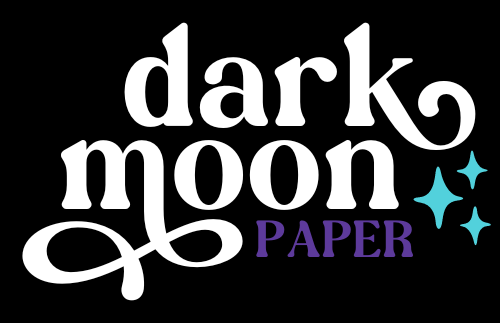
Why use planner stickers?
Planner stickers make organizing easy, fun, and personal! Add color, creativity, and structure to every page, transforming your planner into a tool that reflects you. Perfect for tracking, decorating, and staying inspired daily!
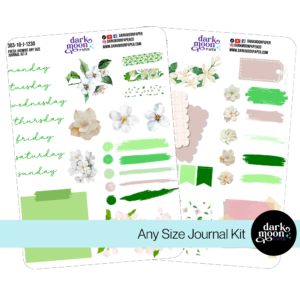
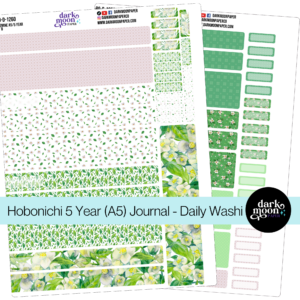
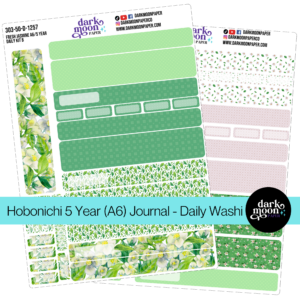
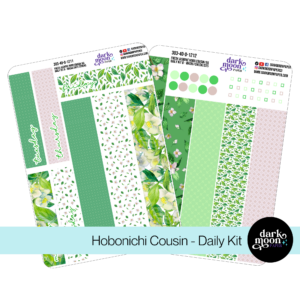
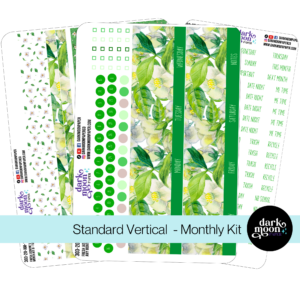
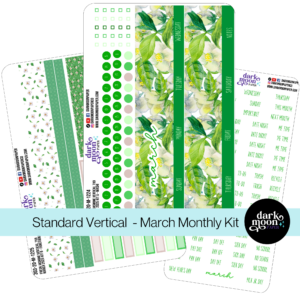
Hello and welcome!
I’m Rachael Snow, a lifelong artist and entrepreneur, and I started Dark Moon Paper to blend my love of art, technology, and the mysterious beauty of the world around us. My sticker kits are meant to set the mood, tell a story, and give you a little escape from the ordinary.
I work from my cozy studio tucked away in the beautiful woods of Oregon, surrounded by nature and a dark night sky full of stars.